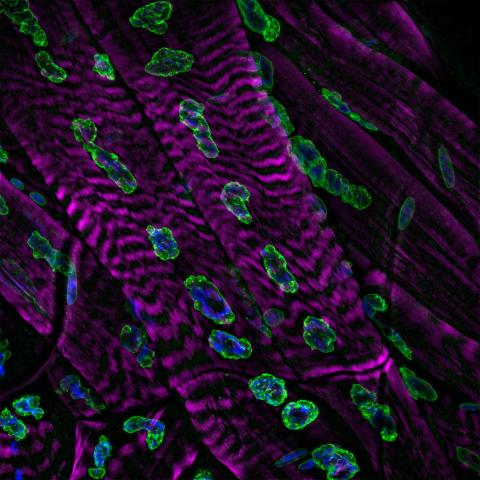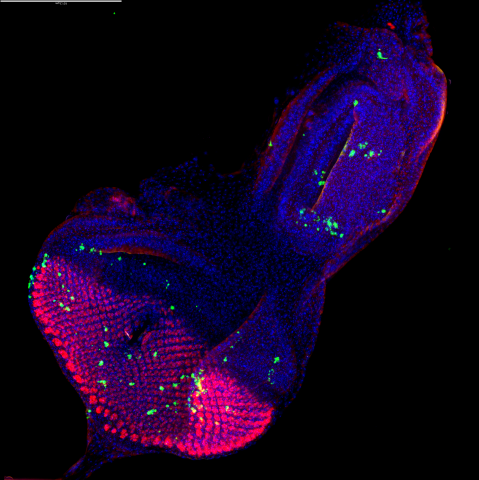
Mutant lamins cause abnormal nuclear shape in muscle. Drosophila larval body wall muscles (magenta) expressing mutant lamins (green) have abnormally shaped nuclei. (Blue indiciates genomic DNA.) In humans, the same mutant lamin causes a rare type of muscular dystrophy.

Mutant Snrnp200 causes cell death in the eye. A Drosophila imaginal eye/antennal disc expressing mutant Snrnp200 show staining with an antibody to a cell death marker (green). (Red indicates differentiated photoreceptors; Blue indicates genomic DNA). In humans, the same mutation causes Retinitis Pigmentosa, a rare vison disorder.
Rare types of muscular dystrophy:
Mutations in the human LMNA gene cause a collection of diseases called laminopathies, such as muscular dystrophies, heart disease, adipose tissues disorders, and early onset aging syndromes. The LMNA gene encodes lamins, intermediate filaments that form a meshwork lining the inner nuclear membrane. Lamins provide structural support for the nucleus and play roles in genome organization, gene expression, and DNA repair. The mechanisms by which mutant lamins cause laminopathies are not well understood and there are currently no therapies. Members of the Wallrath laboratory are investigating the molecular basis of muscular dystrophies and have developed Drosophila (fruit fly) models, which provide ease of genetic and cytological analyses. Human muscle biopsy tissue is used to demonstrate disease relevance of the findings. Their studies have identified signaling pathways altered by mutant lamins and compounds that improve muscle function, providing potential new avenues for therapies.
Rare type of eye disease:
Mutations in genes encoding pre-mRNA splicing factors cause Retinitis Pigmentosa, a vision disorder characterized by progressive loss of photoreceptor function and ultimately blindness. Members of the Wallrath lab are investigating mutations in the SNRNP200 gene encoding a core pre-mRNA splicing factor that possess RNA helicase activity. They have developed Drosophila (fruit fly) models of this disease and found that the flies recapitulate many aspects of the human eye disease, including progressive loss of photoreceptor function. These models are currently being used to understand the pathophysiology of the eye disease and for genetic and pharmacological screens to identify potential therapies.
Wallrath Lab, Fall 2023
(back row, left to right) Brenna Powers (BMB Major), Hailey McCoy-Munger (Biomedical Engineering Major), Sara Mayer (Genetics PhD candidate); (front row, left to right) Paige Wiebke (BMB Major), Lori Wallrath (BMB Professor), Nathan Mohar (Genetics PhD candidate)
Selected Publications
Walker, S.G., Langland, C.J., Viles, J., Hecker, L.A., and Wallrath, L.L. (2023) Drosophila models reveal properties of mutant lamins that give rise to distinct diseases. Cells 12:1142 doi: 10.3390/cells12081142
Shaw, N.M., Rios-Monterrosa, J.L., Fedorchak, G.R., Ketterer M.R., Coombs, G.S., Lammerding, J., and Wallrath, L.L. (2022) Effects of mutant lamins on nucleo-cytoskeletal coupling in Drosophila models of LMNA muscular dystrophy. Front. Cell. Dev. Biol. doi: 10.3389/fcell.2002.934586
Coombs, G.S., Rios-Monterrosa, J.L., Lai, S., Dai, Q., Goll, A.C., Ketterer, M.R., Valdes, M.F., Uche, N., Benjamin, I.J. and Wallrath, L.L. (2021) Modulation of muscle redox and protein aggregation reduces lethality cause by mutant lamins. Redox Biol. 48:102196 doi:10.1016/j.redox.2021.102196
Hinz, B.E., Walker, S.G., Xiong, A. Gogal, R.A., Schnieders, M.J. and Wallrath, L.L. (2021) In silico and in vivo analysis of amino acid substitutions that cause laminopathies. Int. J. Mol. Sci. 22:11226 doi:10.3390/ijms222011226
News
New collaborative publication in Science Advances
Teaching, mentorship, and molecular biology: The lasting legacy of Lori Wallrath
Lori Wallrath selected for teaching award
Dare to Discover Campaign features Nathan Mohar (Wallrath Lab)
Nathan Mohar receives AHA award
Contact Information
Lori Wallrath, PhD
Professor of Biochemistry and Molecular Biology
Carver College of Medicine
University of Iowa
375 Newton Rd, 3136 MERF
Iowa City, IA 52242

